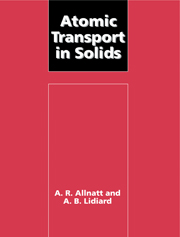Book contents
- Frontmatter
- Contents
- Preface
- List of principal symbols
- 1 Atomic movements in solids – phenomenological equations
- 2 Imperfections in solids
- 3 Statistical thermodynamics of crystals containing point defects
- 4 Non-equilibrium thermodynamics of atomic transport processes in solids
- 5 Some applications of non-equilibrium thermodynamics to solids
- 6 Microscopic theories – the master equation
- 7 Kinetic theory of relaxation processes
- 8 Kinetic theory of isothermal diffusion processes
- 9 The theory of random walks
- 10 Random-walk theories of atomic diffusion
- 11 Transport coefficients of dilute solid solutions – results and applications
- 12 The evaluation of nuclear magnetic relaxation rates
- 13 Theories of concentrated and highly defective systems
- References
- Index
11 - Transport coefficients of dilute solid solutions – results and applications
Published online by Cambridge University Press: 28 December 2009
- Frontmatter
- Contents
- Preface
- List of principal symbols
- 1 Atomic movements in solids – phenomenological equations
- 2 Imperfections in solids
- 3 Statistical thermodynamics of crystals containing point defects
- 4 Non-equilibrium thermodynamics of atomic transport processes in solids
- 5 Some applications of non-equilibrium thermodynamics to solids
- 6 Microscopic theories – the master equation
- 7 Kinetic theory of relaxation processes
- 8 Kinetic theory of isothermal diffusion processes
- 9 The theory of random walks
- 10 Random-walk theories of atomic diffusion
- 11 Transport coefficients of dilute solid solutions – results and applications
- 12 The evaluation of nuclear magnetic relaxation rates
- 13 Theories of concentrated and highly defective systems
- References
- Index
Summary
Introduction
In Chapters 6–10 we have dealt with the general structure of the linear response, kinetic theory and random-walk approaches to the calculation of the phenomenological coefficients and to the dielectric and anelastic response functions. We gave some straightforward examples of approximate results that can be obtained from the general expressions. The mathematical inter-relations between the three approaches demonstrated in those chapters allow the use of common techniques for the evaluation of the expressions for the transport coefficients of particular models.
In the present chapter, which, like Chapters 7–10, is concerned with dilute alloys and solid solutions, we first consider these techniques and then go on to present some results and applications of those results. It divides therefore into three more or less distinct parts. Techniques are the subject of §§11.2 and 11.3, the resulting transport coefficients are the subject of §§11.4–11.6 while various applications are reviewed in §§11.7–11.10.
In Chapters 7 and 8 general expressions were derived for the phenomenological coefficients and response functions from kinetic and linear response theories while consistent expressions for diffusion coefficients were obtained from random walk theory in Chapter 10. The techniques for the evaluation of these expressions are reviewed here in §§11.2 and 11.3. In the first of these sections the techniques are limited to calculations for which, in the terminology introduced in Chapter 10, only one type of jump occurs in the formal analysis. Important examples of such calculations are furnished by evaluations of the three independent phenomenological coefficients LAA, LAB, LBB for dilute binary alloys of cubic structure with transport by single vacancies, simple interstitials or dumb-bell interstitials.
- Type
- Chapter
- Information
- Atomic Transport in Solids , pp. 380 - 459Publisher: Cambridge University PressPrint publication year: 1993
- 1
- Cited by



